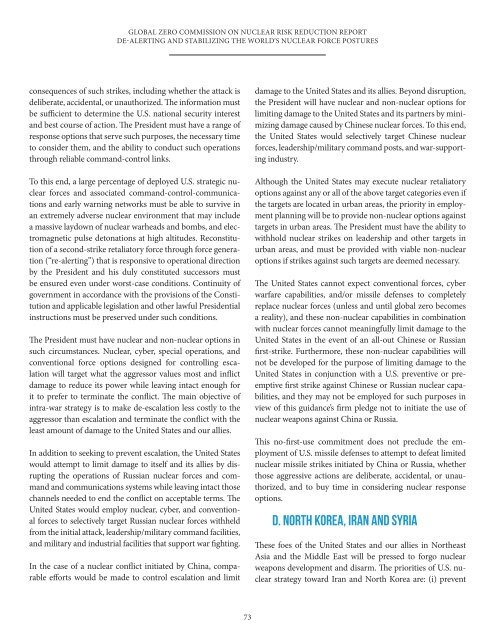global_zero_commission_on_nuclear_risk_reduction_report
global_zero_commission_on_nuclear_risk_reduction_report
global_zero_commission_on_nuclear_risk_reduction_report
You also want an ePaper? Increase the reach of your titles
YUMPU automatically turns print PDFs into web optimized ePapers that Google loves.
GLOBAL ZERO COMMISSION ON NUCLEAR RISK REDUCTION REPORTDE-ALERTING AND STABILIZING THE WORLD’S NUCLEAR FORCE POSTURESc<strong>on</strong>sequences of such strikes, including whether the attack isdeliberate, accidental, or unauthorized. The informati<strong>on</strong> mustbe sufficient to determine the U.S. nati<strong>on</strong>al security interestand best course of acti<strong>on</strong>. The President must have a range ofresp<strong>on</strong>se opti<strong>on</strong>s that serve such purposes, the necessary timeto c<strong>on</strong>sider them, and the ability to c<strong>on</strong>duct such operati<strong>on</strong>sthrough reliable command-c<strong>on</strong>trol links.To this end, a large percentage of deployed U.S. strategic <strong>nuclear</strong>forces and associated command-c<strong>on</strong>trol-communicati<strong>on</strong>sand early warning networks must be able to survive inan extremely adverse <strong>nuclear</strong> envir<strong>on</strong>ment that may includea massive laydown of <strong>nuclear</strong> warheads and bombs, and electromagneticpulse det<strong>on</strong>ati<strong>on</strong>s at high altitudes. Rec<strong>on</strong>stituti<strong>on</strong>of a sec<strong>on</strong>d-strike retaliatory force through force generati<strong>on</strong>(“re-alerting”) that is resp<strong>on</strong>sive to operati<strong>on</strong>al directi<strong>on</strong>by the President and his duly c<strong>on</strong>stituted successors mustbe ensured even under worst-case c<strong>on</strong>diti<strong>on</strong>s. C<strong>on</strong>tinuity ofgovernment in accordance with the provisi<strong>on</strong>s of the C<strong>on</strong>stituti<strong>on</strong>and applicable legislati<strong>on</strong> and other lawful Presidentialinstructi<strong>on</strong>s must be preserved under such c<strong>on</strong>diti<strong>on</strong>s.The President must have <strong>nuclear</strong> and n<strong>on</strong>-<strong>nuclear</strong> opti<strong>on</strong>s insuch circumstances. Nuclear, cyber, special operati<strong>on</strong>s, andc<strong>on</strong>venti<strong>on</strong>al force opti<strong>on</strong>s designed for c<strong>on</strong>trolling escalati<strong>on</strong>will target what the aggressor values most and inflictdamage to reduce its power while leaving intact enough forit to prefer to terminate the c<strong>on</strong>flict. The main objective ofintra-war strategy is to make de-escalati<strong>on</strong> less costly to theaggressor than escalati<strong>on</strong> and terminate the c<strong>on</strong>flict with theleast amount of damage to the United States and our allies.In additi<strong>on</strong> to seeking to prevent escalati<strong>on</strong>, the United Stateswould attempt to limit damage to itself and its allies by disruptingthe operati<strong>on</strong>s of Russian <strong>nuclear</strong> forces and commandand communicati<strong>on</strong>s systems while leaving intact thosechannels needed to end the c<strong>on</strong>flict <strong>on</strong> acceptable terms. TheUnited States would employ <strong>nuclear</strong>, cyber, and c<strong>on</strong>venti<strong>on</strong>alforces to selectively target Russian <strong>nuclear</strong> forces withheldfrom the initial attack, leadership/military command facilities,and military and industrial facilities that support war fighting.In the case of a <strong>nuclear</strong> c<strong>on</strong>flict initiated by China, comparableefforts would be made to c<strong>on</strong>trol escalati<strong>on</strong> and limitdamage to the United States and its allies. Bey<strong>on</strong>d disrupti<strong>on</strong>,the President will have <strong>nuclear</strong> and n<strong>on</strong>-<strong>nuclear</strong> opti<strong>on</strong>s forlimiting damage to the United States and its partners by minimizingdamage caused by Chinese <strong>nuclear</strong> forces. To this end,the United States would selectively target Chinese <strong>nuclear</strong>forces, leadership/military command posts, and war-supportingindustry.Although the United States may execute <strong>nuclear</strong> retaliatoryopti<strong>on</strong>s against any or all of the above target categories even ifthe targets are located in urban areas, the priority in employmentplanning will be to provide n<strong>on</strong>-<strong>nuclear</strong> opti<strong>on</strong>s againsttargets in urban areas. The President must have the ability towithhold <strong>nuclear</strong> strikes <strong>on</strong> leadership and other targets inurban areas, and must be provided with viable n<strong>on</strong>-<strong>nuclear</strong>opti<strong>on</strong>s if strikes against such targets are deemed necessary.The United States cannot expect c<strong>on</strong>venti<strong>on</strong>al forces, cyberwarfare capabilities, and/or missile defenses to completelyreplace <strong>nuclear</strong> forces (unless and until <str<strong>on</strong>g>global</str<strong>on</strong>g> <str<strong>on</strong>g>zero</str<strong>on</strong>g> becomesa reality), and these n<strong>on</strong>-<strong>nuclear</strong> capabilities in combinati<strong>on</strong>with <strong>nuclear</strong> forces cannot meaningfully limit damage to theUnited States in the event of an all-out Chinese or Russianfirst-strike. Furthermore, these n<strong>on</strong>-<strong>nuclear</strong> capabilities willnot be developed for the purpose of limiting damage to theUnited States in c<strong>on</strong>juncti<strong>on</strong> with a U.S. preventive or preemptivefirst strike against Chinese or Russian <strong>nuclear</strong> capabilities,and they may not be employed for such purposes inview of this guidance’s firm pledge not to initiate the use of<strong>nuclear</strong> weap<strong>on</strong>s against China or Russia.This no-first-use commitment does not preclude the employmentof U.S. missile defenses to attempt to defeat limited<strong>nuclear</strong> missile strikes initiated by China or Russia, whetherthose aggressive acti<strong>on</strong>s are deliberate, accidental, or unauthorized,and to buy time in c<strong>on</strong>sidering <strong>nuclear</strong> resp<strong>on</strong>seopti<strong>on</strong>s.D. NORTH KOREA, IRAN AND SYRIAThese foes of the United States and our allies in NortheastAsia and the Middle East will be pressed to forgo <strong>nuclear</strong>weap<strong>on</strong>s development and disarm. The priorities of U.S. <strong>nuclear</strong>strategy toward Iran and North Korea are: (i) prevent73


